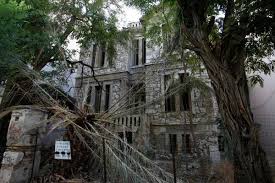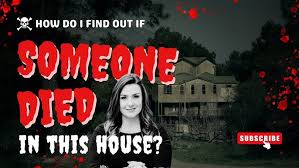How to Find Out If Someone Died in Your House: A Comprehensive Guide



Chính Sách Vận Chuyển Và Đổi Trả Hàng
Miễn phí vận chuyển mọi đơn hàng từ 500K
- Phí ship mặc trong nước 50K
- Thời gian nhận hàng 2-3 ngày trong tuần
- Giao hàng hỏa tốc trong 24h
- Hoàn trả hàng trong 30 ngày nếu không hài lòng
Mô tả sản phẩm
The quiet walls of a home often hold more than just memories; they can also be silent witnesses to significant life events, including death. Whether you’ve just purchased a new property, are considering a rental, have inherited an old family house, or simply possess a deep curiosity about your living space’s past, the question “how to find out if someone died in your house” is a surprisingly common and valid one. While it might seem like a morbid inquiry to some, understanding a property’s full history can offer peace of mind, inform legal decisions, and even satisfy a burgeoning interest in local history or the paranormal. The good news is that, in many cases, finding out if a death occurred within your house is entirely possible, though it often requires a blend of diligent research, official inquiries, and local networking.
This article will guide you through the various methods and resources available to uncover the truth about a property’s past, moving from general investigative principles to specific actionable steps. We will explore official records, community resources, and even subtle physical clues, providing a deductive framework to help you navigate this unique historical detective work.
Why You Might Need to Know: Motivations Behind the Inquiry
The desire to discover if a death occurred in your house stems from a range of motivations, extending beyond mere morbid curiosity. Understanding these reasons can help frame your investigation and prioritize certain types of information.
Purchasing a New Home: Disclosure and Peace of Mind
For prospective homebuyers, this question is often paramount. Many states have specific disclosure laws regarding deaths on a property, particularly if they were violent or occurred recently. Knowing about a prior death can influence a buyer’s decision due to personal comfort, cultural beliefs, or even the perceived “stigma” that might affect future resale value. Transparency about a property’s history contributes significantly to a buyer’s peace of mind.
Renting a Property: Safety and Comfort
While disclosure laws for rentals are generally less stringent than for sales, a tenant might still wish to know if a death occurred on the premises. This could be due to concerns about the property’s history, a desire to avoid potential emotional discomfort, or, in very rare cases, if a death went undiscovered for an extended period, leading to lingering issues that might affect habitability (though this is exceptionally rare in occupied properties).
Inherited Property: Family History and Unknown Circumstances
When inheriting a home, particularly from distant relatives or if family stories are incomplete, discovering past deaths can be crucial for piecing together family history. It might answer lingering questions about an ancestor’s passing, provide context for old photographs or documents, or simply complete the narrative of a beloved family home.
Paranormal Interest: Connecting Events to Activity
For individuals interested in the paranormal, knowing about past deaths in a house is often the first step in understanding potential ghostly activity. Many paranormal theories posit that significant emotional or traumatic events, such as a death, can leave an energetic imprint, leading to unexplained phenomena. Identifying a historical death can provide a foundational “case file” for such investigations.
General Curiosity and Property History
Sometimes, the motivation is simply a deep-seated curiosity about the history of a building. Homes, especially older ones, have witnessed countless lives and events. Understanding if a death occurred is simply another layer of that rich historical tapestry, connecting the present occupants to those who came before.
Official Avenues: Uncovering Records and Public Information
The most reliable way to find out if someone died in your house is to consult official records. These are often public or accessible through specific requests, providing concrete evidence of past events.
Public Records and Vital Statistics
Death certificates are the primary official record of a person’s passing. They typically include the place of death, which can pinpoint a specific address. However, accessing these records directly can be challenging due to privacy laws. Generally, death certificates are public records after a certain period (e.g., 50-75 years), or you may need to demonstrate a direct familial relationship or legal interest to obtain more recent ones.
- County Clerk/Recorder’s Office: Many local county offices maintain vital records, including death certificates. Start by contacting the office in the county where the property is located.
- State Department of Health/Vital Statistics: Each state has a central repository for vital records. Their websites often provide information on how to request copies of death certificates, including eligibility requirements and fees.
- Online Genealogy Sites: Websites like Ancestry.com or FamilySearch.org may have digitized historical death records that mention addresses, especially for older properties.
Law Enforcement and Emergency Services
If a death was unnatural (e.g., suicide, homicide, accident) or occurred suddenly and unexpectedly, law enforcement or emergency medical services (EMS) would have responded. Their records can be a valuable source of information.
- Local Police Department: You can submit a Freedom of Information Act (FOIA) request (or equivalent state-level public records request) to the local police department for incident reports related to a specific address. Be prepared for potential redactions due to privacy concerns, especially for ongoing investigations or sensitive personal details.
- Coroner/Medical Examiner’s Office: These offices investigate deaths that are suspicious, unexplained, or violent. Their records may contain detailed reports about deaths occurring at specific addresses. Access rules vary by jurisdiction and the nature of the death.
- Fire Department/EMS: If emergency medical personnel were dispatched to the address for a medical emergency that resulted in death, their records might contain an incident report. These are generally harder to access due to medical privacy (HIPAA in the U.S.).
Court Records and Legal Filings
Certain types of deaths can lead to court proceedings, which are typically public records.
- Probate Court: When someone dies, their estate often goes through probate. Probate records might list the deceased’s last known address and other details related to their death, especially if it was sudden and required a will to be executed quickly.
- Criminal Court Records: If a homicide occurred, the criminal trial records (indictments, court transcripts, sentencing) would be public and detail the location of the crime.
- Civil Court Records: Wrongful death lawsuits or other civil disputes stemming from a death might also contain information about the location.
Historical Societies and Local Archives
For older properties, local historical societies, public libraries, and university archives can be treasure troves of information.
- Obituaries and Newspaper Archives: Old newspapers often published obituaries that mentioned the deceased’s residence. Many local libraries have digitized historical newspaper archives or microfilms you can search by address or name.
- City Directories: Before phone books, city directories listed residents by address, which can help you track who lived in your house over time. You can then cross-reference names with death records.
- Local Historians: Sometimes, local historians or long-time residents involved in historical societies have informal knowledge or private collections of information about specific properties.
Investigating the Property and Its Community
Beyond official documents, invaluable insights can be gained from those who know the property and its surrounding community.
Real Estate Disclosure Forms
In many jurisdictions, sellers are legally obligated to disclose “material facts” about a property. This often includes deaths that occurred on the premises, especially if they were violent (homicide, suicide) or recent. Natural deaths may or may not require disclosure depending on state law. Always review the seller’s disclosure statement thoroughly when buying a property. If you suspect an undisclosed death, consult with a real estate attorney.
Engaging with Current and Former Residents
The real estate agent who handled the sale of the house might be able to provide information, although their disclosure obligations are governed by law. If you can identify previous owners, a direct, polite inquiry might yield answers. This is often challenging due to privacy, but sometimes public records (like property deeds) can help you trace ownership history.
Leveraging Neighborhood Knowledge
Neighbors, especially long-time residents, are often the best informal source of a property’s history. They may recall past events, previous occupants, or even tragedies that occurred years ago. Approaching neighbors respectfully, explaining your curiosity about the house’s history, can often open doors to fascinating stories, including details about past deaths. Be mindful of privacy and avoid being overly intrusive.
Interpreting Subtler Clues and Unconventional Paths
While not definitive proof, certain anomalies or services can prompt further investigation into whether someone died in your house.
Physical Evidence and Remediation
In very rare cases, if a death went undiscovered for an extended period, there might be lingering physical evidence or signs of extensive remediation. This could include unusual repairs, specific areas of flooring or walls replaced without obvious reason, or persistent faint odors that seem to defy typical cleaning efforts. A thorough home inspection by a qualified professional might identify such anomalies, though their primary purpose is structural, not historical.
The Role of Intuition and Paranormal Claims
For those sensitive to their environment, a “feeling” about a house can sometimes be a catalyst for investigation. While subjective, strong unexplained sensations, or even reported paranormal activity, can prompt a deeper dive into the property’s past, often leading back to significant historical events, including deaths. It’s important to approach such experiences with a balanced perspective, combining them with objective research.
Online Databases and “Death House” Services
Websites like DiedInHouse.com offer services to research if a death has occurred at a specific address. These services typically compile information from various public records and news archives. While convenient, they often come with a fee and their completeness can vary. They can be a good starting point but should not be considered the sole definitive source of truth.
Legal and Ethical Considerations
When seeking information about deaths in a house, it&rsquos crucial to be aware of the legal and ethical landscape.
Understanding Disclosure Laws
Disclosure laws regarding deaths in a property vary significantly by state and country. Some states (e.g., California) require disclosure of any death within the past three years, while others (e.g., New York) generally do not consider a non-violent death a material fact requiring disclosure. “Psychologically impacted” properties (stigmatized properties) due to violent crimes or suicides are often handled differently than natural deaths. Consult with a local real estate attorney to understand the specific disclosure requirements in your area.
Privacy vs. Public Interest
While public records exist, there’s a delicate balance between the public’s right to know and an individual’s right to privacy. Be mindful of how you obtain and use information, especially concerning deceased individuals and their families. Respectful inquiry is key.
The Psychological and Financial Impact
Discovering that someone died in your house can have a psychological impact, whether it’s simply a shift in how you view the home or, in more sensitive cases, a source of distress. From a financial perspective, a history of death, particularly violent death, can sometimes affect a property’s market value or its attractiveness to potential buyers, though this “stigma” often diminishes over time.
Practical Steps to Discover if Someone Died in Your House
To effectively investigate if someone died in your house, follow a systematic approach:
Step-by-Step Approach
- Step 1: Gather Basic Property Information. Collect the full address, property’s age, and any known previous owner names or dates of ownership if you have them.
- Step 2: Check Seller’s Disclosure. If you purchased the home recently, review the disclosure statement provided by the seller or their agent for any mentions of past deaths or events.
- Step 3: Begin with Online Searches. Use general search engines with keywords like “[your address] death,” “[previous owner name] obituary,” “[city/county] newspaper archives.” Consider paid services like DiedInHouse.com as a preliminary check.
- Step 4: Contact Local County Offices. Reach out to the County Clerk or Recorder’s office for vital records. Inquire about the process for obtaining historical death certificates tied to an address.
- Step 5: Contact Local Law Enforcement. Submit a public records request (FOIA or equivalent) to the local police department and/or coroner’s office, specifying the address and requesting incident reports or records of deaths at that location. Be specific but open to what they can provide.
- Step 6: Visit Local Libraries/Historical Societies. Explore their archives for old city directories, newspaper microfilms, and local history collections. Librarians are often excellent resources for navigating these materials.
- Step 7: Talk to Neighbors. Introduce yourself and politely inquire about the history of the neighborhood and the property. Long-time residents often possess invaluable anecdotal information.
- Step 8: Consult a Professional (If Necessary). If your efforts yield no definitive results but your conviction remains strong, or if there are legal implications, consider consulting a real estate attorney or a professional genealogist/private investigator specializing in public records.
- Step 9: Document Everything. Keep a detailed log of who you contacted, when, what information they provided (or didn’t), and any fees paid. This helps in tracking your progress and provides a paper trail if further action is needed.
Conclusion
The question “how to find out if someone died in your house” is an intriguing quest into a property’s hidden narrative. While the answer may not always be immediately apparent, a systematic and persistent approach using official records, community resources, and careful observation can often unveil the truth. Whether driven by a desire for legal transparency, historical understanding, or simply peace of mind, exploring a home’s full story, including its more somber chapters, can provide a deeper connection to your living space and the lives that shaped it. Remember to approach your investigation respectfully, navigate legal disclosures, and interpret findings with an open yet critical mind, ultimately achieving a clearer understanding of the place you call home.